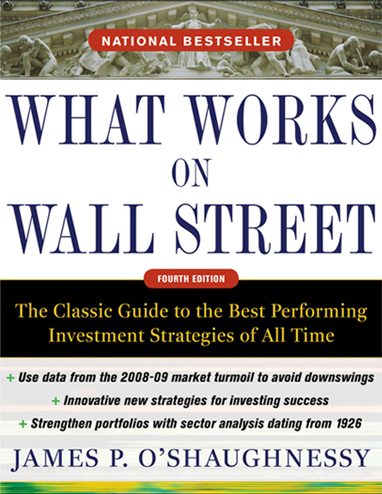OVERVIEW
Which investment strategies are winners—and which are losers? What factors most reliably indicate that a stock will rise or fall? Are value strategies better than growth? Do small capitalization stocks do better than large? What is the worst-case scenario for the various investment strategies and how long did it take for them to recover? Do these strategies work outside the United States?
James O’Shaughnessy answers all of these questions in What Works on Wall Street, Fourth Edition: The Classic Guide to the Best-Performing Investment Strategies of All Time (McGraw-Hill Professional; November 2011; HC, $45.00). Containing all new data, this is the only investing guide that allows you to see today’s market in its proper context— as part of the historical ebb and flow of the stock market. And when you see the data, you’ll see there is no argument: Stocks work.
Recent history has witnessed one of the worst stock market beatings ever. As a result, abysmal returns are being called “the new normal,” financial “experts” are ringing the death knell of buy-and-hold, and investors’ faith in equities has hit an all-time low. You have two choices. You can abandon the stock market based on what is happening today. Or you can invest today based on what will happen in the future.
Having been called a “statistical guru” and “legendary investor,” O’Shaughnessy shares his methodical, scientific, and results-based method for making intelligent stock market decisions. He says, “To make the best investment plans for the future, investors need access to unbiased, long-term performance results.” And that is exactly what he gives you in this history-making book. Now in its second decade of helping investors succeed with stocks, What Works on Wall Street continues to provide the most effective investing strategies, presenting incontrovertible data on what works and what doesn’t.
Updated with current statistics and brand-new features, O’Shaughnessy offers data on almost 90 years of market performance, including: stocks ranked by market capitalization; price-to-earnings ratios; EBITDA-to-enterprise value; price-to-cash flow, -sales, and -book ratios; dividend, buyback, and shareholder yields; one-year earnings-per-share percentage changes; accounting and leverage ratios; sector specific factor analysis; new multifactor strategies.
Providing you with unparalleled insights into stock performance going back to 1926, What Works on Wall Street is a refreshingly calming, objective view of a subject that is usually wrapped in drama, hyperbole, and opinions that are plain wrong. This comprehensive guide provides the objective facts and winning strategies you need; all you have to do is make the decision to ignore the so-called market experts and rely on the long-proven approach that has made What Works on Wall Street an investing classic.
What Works on Wall Street will yet again reach experienced individual investors, self-directed investors, and institutional investors across the board: This volume can be used in bull and bear markets. Don’t mess with success—start off 2013 armed with best practices for investing!


